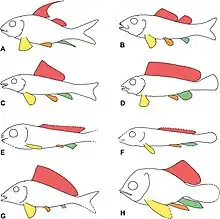Macrosemiiformes
Macrosemiiformes is an extinct order of ray-finned fish with one family, Macrosemiidae. The group evolved during the Late Triassic and disappeared during the Late Cretaceous. The group has been found in rock formations in Africa, Australia, Eurasia and North America.[1] They members of Ginglymodi, meaning that their closest living relatives are gars, with them either being placed as the most basal members of the clade, or as nested within the Semionotiformes.[2] Many members of the family have elongated dorsal fins, often associated with adjacent area of skin which was free of scales. These fins were likely undulated for use in precision swimming. Their body morphology suggests that they were slow swimmers that were capable of maneuvering around complex topography, such as reef environments.[3]
| Macrosemiiformes Temporal range: Late Triassic - Late Cretaceous | |
|---|---|
 | |
| Various Macrosemiiform fishes, from top to bottom A. Macrosemius rostratus (Germany, Late Jurassic) B. Legnonotus krambergeri (Austria, Late Triassic) C. Propterus elongatus (Germany, Late Jurassic) D. Propterus microstomus (Germany, Late Jurassic)E. Histionotus oberndorferi (Germany, Late Jurassic) F. Notagogus denticulatus (Germany, Late Jurassic) | |
| Scientific classification | |
| Domain: | Eukaryota |
| Kingdom: | Animalia |
| Phylum: | Chordata |
| Class: | Actinopterygii |
| Infraclass: | Holostei |
| Clade: | Ginglymodi |
| Order: | †Macrosemiiformes Carroll, 1988 |
| Family: | †Macrosemiidae Carroll, 1988 |
| Genera | |
|
See text | |

Taxonomy
- †Order Macrosemiiformes
- †Family Macrosemiidae, Thiollière, 1858
- Genus †Eosemionotus[2]
- Genus †Aphanepygus
- Genus †Disticholepis
- Genus †Enchelyolepis
- Genus †Orthurus
- Genus †Petalopteryx
- Genus †Neonotagogus
- Genus †Histionotus
- Genus †Legnonotus
- Genus †Macrosemius
- Genus †Propterus
- Incetae sedis
- Genus †Uarbryichthys[4]
- Genus †Voelklichthys[4]
- †Family Macrosemiidae, Thiollière, 1858
Timeline of genera

References
- "Macrosemiiformes". Palaeos vertebrates. Archived from the original on 29 August 2010. Retrieved 20 August 2009.
- López-Arbarello, Adriana; Bürgin, Toni; Furrer, Heinz; Stockar, Rudolf (2019). "Taxonomy and phylogeny of Eosemionotus Stolley, 1920 (Neopterygii: Ginglymodi) from the Middle Triassic of Europe". Palaeontologia Electronica. doi:10.26879/904.
- Cawley, John J.; Marramà, Giuseppe; Carnevale, Giorgio; Villafaña, Jaime A.; López‐Romero, Faviel A.; Kriwet, Jürgen (February 2021). "Rise and fall of †Pycnodontiformes: Diversity, competition and extinction of a successful fish clade". Ecology and Evolution. 11 (4): 1769–1796. doi:10.1002/ece3.7168. ISSN 2045-7758. PMC 7882952. PMID 33614003.
- Arratia, G.; Schultze, H.-P. (2012-01-01). "The macrosemiiform fish companion of the Late Jurassic theropod Juravenator from Schamhaupten, Bavaria, Germany". Fossil Record. 15 (1): 5–25. doi:10.5194/fr-15-5-2012. ISSN 2193-0074.
- Sepkoski, Jack (2002). "A compendium of fossil marine animal genera". Bulletins of American Paleontology. 364: 560. Archived from the original on 2009-02-20. Retrieved 2011-05-17.
.jpg.webp)